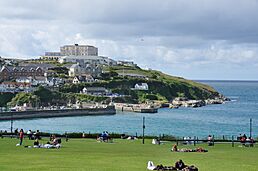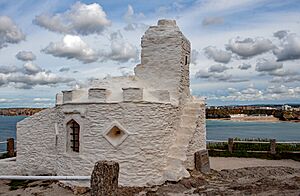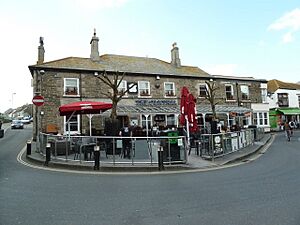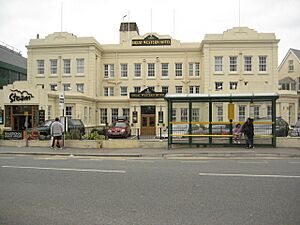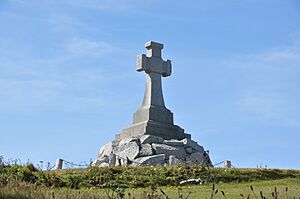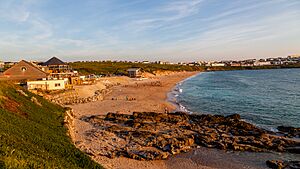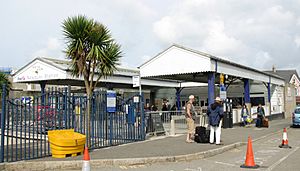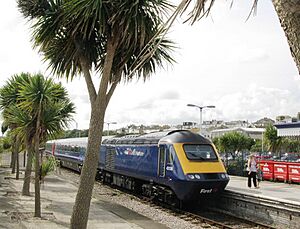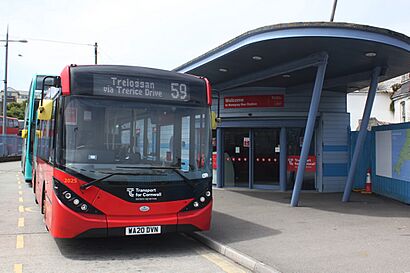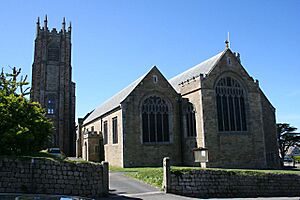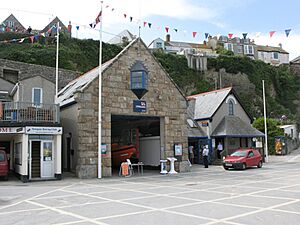Newquay facts for kids
Quick facts for kids Newquay
|
|
|---|---|
| Town | |
|
View of the harbour from the Killacourt
The Huers House
Parish Church
The Island house
The Headland Hotel
Great Western Hotel
View of the harbour from the Killacourt |
|
Coat of arms |
|
| Lua error in Module:Location_map at line 530: Unable to find the specified location map definition: "Module:Location map/data/Cornwall (mainland)" does not exist. | |
| Area | 2.557 sq mi (6.62 km2) |
| Population | 23,600 (2021 census) |
| • Density | 9,230/sq mi (3,560/km2) |
| OS grid reference | SW815615 |
| Civil parish |
|
| Unitary authority | |
| Ceremonial county | |
| Region | |
| Country | England |
| Sovereign state | United Kingdom |
| Post town | NEWQUAY |
| Postcode district | TR7, TR8 |
| Dialling code | 01637 |
| Police | Devon and Cornwall |
| Fire | Cornwall |
| Ambulance | South Western |
| EU Parliament | South West England |
| UK Parliament |
|
| Website | newquay.gov.uk |
Newquay (pronounced NEW-kee) is a town on the north coast of Cornwall, England. It is a civil parish (a local government area) and a popular seaside resort. Newquay is also a growing hub for aerospace industries, with an airport and a spaceport. It has a long history as a fishing port on the North Atlantic coast. The town is about 12 miles (19 km) north of Truro and 20 miles (32 km) west of Bodmin.
Newquay is bordered by the River Gannel and its salt marsh to the south. To the north-east, you'll find the Porth Valley. The western side of the town meets the Atlantic Ocean at Fistral Bay. Newquay started as a small fishing village and has grown steadily inland since the late 1800s.
In 2021, the town's permanent population was 23,600. However, during the summer, the number of people in Newquay can increase a lot due to tourists.
Contents
Newquay's Past
Ancient Times
Evidence of early people in Newquay can be seen at The Barrowfields. These are pre-historic burial mounds about 400 meters (437 yards) from Trevelgue. Long ago, there were up to fifteen mounds, but only a few remain today. When archaeologists dug there, they found old cooking pots and a pottery urn. This urn held the remains of a Bronze Age leader who was buried around 3,500 years ago.
In 1987, signs of a Bronze Age village were discovered at Trethellan Farm. This site overlooks the River Gannel.
The first real settlement in the Newquay area was an Iron Age hill fort. This fort was also an industrial center. It used the iron found nearby and the natural defenses of Trevelgue Head. People lived there continuously from about 300 BC to 500 or 600 AD. Later, a house from the Dark Ages was built on the headland.
The Domesday Book
The settlement we now call Newquay was not mentioned in the Domesday Book. This was a big survey of England completed in 1086. However, a piece of land called Treninnick, now part of Newquay, was recorded. Treninnick was then part of the Coswarth manor. It was a small area of about 30 acres (12 hectares) with five sheep. The village of Crantock is the only other place near Newquay mentioned in the Domesday Book.
Building a "New Quay"
In 1439, Edmund Lacey, the Bishop of Exeter, gave special permission to raise money. This money was for building a new quay (a landing place for ships). This is where the town got its modern name. However, this fundraising effort did not work well. The harbour stayed mostly undeveloped until the early 1600s. It likely had several short wooden piers since the 1400s, and maybe even earlier.
From Medieval Times to Early Modern Period
Modern Newquay began as a small group of homes called "Towan" in the medieval period. This was where the Central Inn stands today. About 200 meters (660 feet) away was another settlement called "New Quay." This name referred to a small harbour within the Towan Blystra area. The two settlements were connected by a path that became today's Fore Street. Back then, people mainly made a living from fishing, farming, and some mining.
The first mention of a fish market in the area was in 1571. This market might have been in what is now Central Square. Fish were also traded directly at the quay and in nearby cellars. The pub known as 'The Central' (rebuilt in 1859) became a busy place for trade. Farmers would park their wagons of grain in the square and do business inside the inn.
In 1615, Thomas Stuer, who owned the land, asked for permission to build a single pier. This marked the start of the modern harbour's development.
The Huer's Hut
The Huer's Hut in Newquay was a special lookout point. A person called a huer would watch from here for groups of pilchard fish. They could tell the fish were coming when the water turned a dark reddish-brown. Also, many seagulls would dive down to eat the fish. The huer would shout "hevva, hevva" or use a trumpet to announce the fish. Then, they would wave tree branches to show the townspeople where the fish were. The word "huer" comes from the same root as "hue" in "hue and cry," meaning to shout out.
The Huer's Hut in Newquay is a very old and important building. It is believed to be from the late 1700s or early 1800s. However, a sign on the hut says it might be from the 1300s. This sign also suggests it might have been used as a hermitage (a place for a religious hermit) or a lighthouse even earlier.
The hut was repaired in 1836. It became a protected historic building in 1951 and is now a grade II* listed building.
The Central Inn
The exact beginnings of the original inn where the Central Inn now stands are not clear. An inn was recorded here in 1755. It was likely built of stone with a thatched roof, later changed to slate. It was an important place for trade. Sarah Teague Husband, in her book "Old Newquay," described the inn in the 1850s as being "two or three hundred years old" and in poor condition.
The inn was rebuilt in 1859. It was known as the Commercial Inn until the early 1900s.
Dr. William Borlase's Visit in 1755
Dr. William Borlase, a Cornish historian and a church leader, visited Towan Blystra in 1755. He wrote about seeing "about twelve houses called Towan Blystra." He also described the "New Quay" in St Columb Parish. He noted a small pier and a gap cut into the rock. This gap allowed small ships into a basin that could hold about six ships. He also mentioned a "dwelling house and a commodious cellar lately built" on the cliff.
The dwelling house Borlase mentioned is thought to be 'Quay House'. This is one of the oldest buildings in Newquay.
The 1800s
The first national British census in 1801 counted about 1,300 people in the area that would become Newquay. This included smaller settlements within the St Columb Minor parish.
In 1832, a businessman from London named Richard Lomax bought the Towan Blystra area. This included the small harbour at what was becoming known as New Quay.
Lomax started building the north and south quays. However, he passed away in 1837 before his harbour was finished.
The harbour was busiest in the 25 years after the Cornwall Minerals Railway bought it in the 1870s. In 1872, a middle jetty was added to handle more ships.
North of the harbour, there were fish cellars in the 1800s. Here, pilchard fish were salted and packed into barrels. Only two areas, Fly cellars and Active cellars, remain today.
A large house called the Tower was built for the Molesworth family in 1835. It had a castle-like tower and a private chapel. This was because the family was Roman Catholics and there was no Catholic church nearby. The Tower later became the golf club house. After passenger trains arrived in June 1876, Newquay grew quickly. Many houses and hotels began to appear.
Victorian Hotels
Several large hotels were built around the late 1800s. The first was the Great Western Hotel, which opened in 1879. It was rebuilt in the 1930s. Other early luxury hotels included the Victoria (1899), the Atlantic (1892), and the Headland (1900) near Fistral Beach. Many smaller hotels also opened. Some were once large houses built by wealthy visitors as holiday homes. This was especially true along Narrowcliff.
The 1900s
Three churches were built in the early 1900s. This included the current parish church of St Michael the Archangel, which was dedicated in 1911. The town grew eastward, reaching the area around the railway station. Station Road became Cliff Road around 1930. Houses beyond, along Narrowcliff, were also turned into hotels.
During the First World War, the town's edge was a little further along what is now Narrowcliff. After the war, new houses and streets were built in the Chester Road area. Houses also spread along the country lane to St Columb Minor, about 2 miles (3 km) away. This road was updated and named Henver Road in the 1930s. Building continued until the Second World War. By then, much of Henver Road had houses on both sides.
A successful knitting industry started in Newquay in the early 1900s. In 1905, Madame Hawke began selling machine-knitted clothes. A large department store, Debenhams, ordered from her. She opened a factory in Crantock Street, which is now housing. Other knitting companies also started in the town.
In the early 1950s, the last houses were built along Henver Road. After that, there was almost a continuous line of buildings from St Columb Minor to the town center. The Doublestiles estate, north of Henver Road, was also built in the early 1950s. Further development became the Lewarne Estate, extending the town towards Porth.
Other areas that grew between the wars included Pentire (also called West Newquay) and the Trenance Valley. Streets from the 1920s included St Thomas Road, which led to the town's new hospital.
More recently, development has been on a larger scale. Until the late 1960s, a train passenger would not see buildings along the line until the Trenance Viaduct. Today, the town starts about 1.5 miles (2.4 km) inland from the viaduct. Other growth areas are near St Columb Minor and towards the Gannel. More building beyond Treninnick, south of the Trenance Valley, has extended the town to Lane. The Treninnick/Treloggan development in the 1970s and 1980s included homes, an industrial area, and large shops.
The 2000s
In 2007, one of Britain's worst hotel fires happened at the Penhallow Hotel. It overlooked Towan beach. Three people died because the hotel did not follow fire safety rules. The building was later torn down and replaced.
In 2012, the first part of a new housing development began at Tregunnel Hill. This project, by the Duchy of Cornwall, has 174 homes with traditional designs.
A similar, much larger development is now happening inland. Construction is well underway at a big site called Nansledan ('broad valley' in Cornish). Plans for 800 homes were approved in December 2013. The plan now includes over 4,000 homes, shops, a supermarket, a church, and a primary school. The school opened in September 2019. Like Tregunnel Hill, the buildings have traditional designs, and all street names are in Cornish.
Places like Trencreek, Porth, and St Columb Minor have become suburbs of Newquay. It was once thought that by the 2030s, Newquay might stretch to Quintrell Downs, 3 miles (5 km) from the town center. However, the Newquay Neighbourhood Development Plan, approved in April 2019, says it's important to keep a 'green buffer' between Newquay and Quintrell Downs.
In April 2012, the Aerohub enterprise zone for aerospace businesses was set up at Newquay Airport. In September 2014, funding was approved for a £6 million Aerohub Business Park there. A plan to launch space vehicles from a new spaceport next to the airport moved forward in July 2018. A contract was signed with Virgin Orbit. The first launch from the spaceport, called Spaceport Cornwall, happened on January 9, 2023. The LauncherOne rocket launched successfully from the carrier aircraft, Cosmic Girl. However, the rocket's second stage had a problem, and the vehicle and its satellites did not reach orbit.
How Newquay is Governed
Newquay Town Council
| Newquay Town Council | |
|---|---|
| Type | |
| Type |
Civil Parish
|
| Established | 1868 (as a local board) |
| Leadership | |
|
Drew Creek
|
|
| Structure | |
| Seats | 18 Councillors |
| Authority | Cornwall Council |
| Meeting place | |
| Municipal Buildings, Newquay | |
| Website | |
| https://www.newquay.gov.uk/ | |
Before the Newquay Council was formed, the Local Government Act of 1858 allowed for the creation of local government areas. In 1868, a Local Board was set up in Newquay.
The Local Government Act 1894 created urban and rural districts. This led to the Newquay Urban District. The Newquay Urban District Council was ended in 1974 as part of a local government change. In that year, the Local Government Act 1972 combined the areas of St. Austell with Fowey, Newquay urban district, and St Austell Rural District.
The new council was called the Borough of Restormel. However, it was also ended on April 1, 2009, as part of changes to local government in England. Cornwall became a unitary authority. This means there are now two levels of local government in the county. Cornwall Council handles things like council tax, schools, roads, the harbour, and trash collection. Locally, Newquay Town Council has taken on more duties from Cornwall Council. These include the library, public toilets, and managing the Killacourt open space and a car park.
The Member of Parliament (MP) for St Austell and Newquay is Noah Law from the Labour Party. He won the seat in the General Election on July 4, 2024. The previous MP was Steve Double from the Conservative Party.
On May 1, 2024, Newquay town councillors chose Drew Creek as Mayor for the next 12 months. The previous mayor, Margaret North, is now the deputy mayor.
Newquay's Geography
Climate
Like the rest of the British Isles and South West England, Newquay has a maritime climate. This means it has cool summers and mild winters. The closest weather station is at Newquay Airport, about 3.5 miles (5.6 km) north-east of the town center. Since 1960, temperatures have ranged from 31.3°C (88.3°F) in June 1976 and August 1995 to -9.0°C (15.8°F) in January 1987.
| Climate data for Newquay Cornwall Airport WMO ID: 03817; coordinates 50°26′19″N 4°59′47″W / 50.43869°N 4.99645°W; elevation: 103 m (338 ft); 1991–2020 normals, extremes 1960–present |
|||||||||||||
|---|---|---|---|---|---|---|---|---|---|---|---|---|---|
| Month | Jan | Feb | Mar | Apr | May | Jun | Jul | Aug | Sep | Oct | Nov | Dec | Year |
| Record high °C (°F) | 15.1 (59.2) |
18.4 (65.1) |
22.2 (72.0) |
24.3 (75.7) |
27.9 (82.2) |
31.3 (88.3) |
31.4 (88.5) |
32.4 (90.3) |
29.9 (85.8) |
26.5 (79.7) |
19.2 (66.6) |
16.5 (61.7) |
32.4 (90.3) |
| Mean maximum °C (°F) | 13.0 (55.4) |
13.3 (55.9) |
16.8 (62.2) |
18.9 (66.0) |
22.6 (72.7) |
25.0 (77.0) |
25.8 (78.4) |
24.0 (75.2) |
22.5 (72.5) |
20.7 (69.3) |
16.4 (61.5) |
13.6 (56.5) |
27.3 (81.1) |
| Mean daily maximum °C (°F) | 9.0 (48.2) |
9.0 (48.2) |
10.4 (50.7) |
12.5 (54.5) |
15.1 (59.2) |
17.5 (63.5) |
19.1 (66.4) |
19.1 (66.4) |
17.7 (63.9) |
14.6 (58.3) |
11.7 (53.1) |
9.7 (49.5) |
13.8 (56.8) |
| Daily mean °C (°F) | 6.7 (44.1) |
6.6 (43.9) |
7.7 (45.9) |
9.4 (48.9) |
12.0 (53.6) |
14.5 (58.1) |
16.3 (61.3) |
16.4 (61.5) |
14.9 (58.8) |
12.2 (54.0) |
9.4 (48.9) |
7.4 (45.3) |
11.1 (52.0) |
| Mean daily minimum °C (°F) | 4.3 (39.7) |
4.1 (39.4) |
5.1 (41.2) |
6.4 (43.5) |
8.9 (48.0) |
11.5 (52.7) |
13.5 (56.3) |
13.7 (56.7) |
12.1 (53.8) |
9.8 (49.6) |
7.1 (44.8) |
5.1 (41.2) |
8.5 (47.3) |
| Mean minimum °C (°F) | -0.0 (32.0) |
0.7 (33.3) |
0.7 (33.3) |
3.1 (37.6) |
5.5 (41.9) |
8.6 (47.5) |
10.9 (51.6) |
10.6 (51.1) |
8.5 (47.3) |
5.4 (41.7) |
4.2 (39.6) |
1.5 (34.7) |
−1.6 (29.1) |
| Record low °C (°F) | −9.0 (15.8) |
−8.5 (16.7) |
−8.5 (16.7) |
−2.1 (28.2) |
1.0 (33.8) |
2.7 (36.9) |
7.4 (45.3) |
7.2 (45.0) |
4.9 (40.8) |
−0.1 (31.8) |
−4.2 (24.4) |
−6.7 (19.9) |
−9 (16) |
| Average precipitation mm (inches) | 109.0 (4.29) |
83.2 (3.28) |
68.8 (2.71) |
65.7 (2.59) |
58.4 (2.30) |
63.1 (2.48) |
71.5 (2.81) |
71.3 (2.81) |
77.2 (3.04) |
108.0 (4.25) |
127.7 (5.03) |
115.7 (4.56) |
1,019.4 (40.13) |
| Average precipitation days (≥ 1.0 mm) | 16.4 | 13.3 | 12.4 | 11.1 | 9.8 | 10.1 | 11.4 | 12.1 | 11.5 | 15.2 | 17.8 | 17.1 | 158.1 |
| Average relative humidity (%) (daily average) | 86 | 85 | 84 | 82 | 82 | 84 | 85 | 85 | 85 | 86 | 86 | 86 | 85 |
| Average dew point °C (°F) | 4 (39) |
4 (39) |
5 (41) |
6 (43) |
8 (46) |
11 (52) |
13 (55) |
13 (55) |
11 (52) |
9 (48) |
7 (45) |
5 (41) |
8 (46) |
| Mean monthly sunshine hours | 67.8 | 91.1 | 133.3 | 194.3 | 224.2 | 219.5 | 207.5 | 196.7 | 167.1 | 119.8 | 75.1 | 61.6 | 1,758 |
| Source 1: Met Office | |||||||||||||
| Source 2: Royal Dutch Meteorological Institute Source #3: Newquay Weather Station
Source 4: Time and Date |
|||||||||||||
Geology of Newquay
The ground beneath Newquay is made of rocks from the Devonian age. These rocks are part of the Meadfoot Group. They are layers of mudstone, siltstone, and sandstone, with some limestone. Newer deposits of wind-blown sand cover the bedrock in the western part of town. Near Fistral Beach, you can find some lead and silver minerals. These are linked to the Cornish granite that runs through much of the peninsula.
Newquay's Economy
Tourism in Newquay
Newquay has been a popular place for tourists for over a hundred years. This is mainly because of its beautiful coastline and nine long, sandy beaches. One of these is Fistral Beach, which is known as one of the best surfing beaches in the British Isles. About 25,000 people live in Newquay. However, in the summer, the population can grow to 100,000 or more because there are so many places for holidaymakers to stay.
During the 1900s, the town grew in different areas. Trenance Leisure Gardens are in a wooded valley on the quieter edge of Newquay. They stretch down to the Gannel Estuary. Since the Edwardian era, these gardens have offered fun for tourists. They have walks, tennis courts, and a bowling green. A stone railway bridge crosses the gardens. This bridge was rebuilt just before the Second World War. The boating lake was dug in the 1930s to create jobs during tough economic times. In the late 1960s, the council added more attractions. These included mini-golf, a swimming pool, the Little Western Railway miniature railway (opened in 1968), and Newquay Zoo (opened in 1969).
Newquay was also famous for the "Run to the Sun" event. This started on Fistral Beach in 1987. For many years, it took place at Trevelgue Holiday Park during the May holiday weekend. People came to town in Volkswagen camper vans, Volkswagen Beetles, and other custom cars. The last "Run to the Sun" was in 2014. However, in 2023, it was announced that the event would return on May 27 to a new location at St Mawgan, just outside Newquay.
Other recent events include the large Boardmasters music festival. This festival brings another 50,000 visitors over one weekend in early August. It is held at Watergate Bay (outside the main town) and Fistral Beach. Cornwall Pride moved to Newquay from Truro in 2017. In 2018, it took place on the last Saturday in August.
The 630-mile (1,014 km) South West Coast Path walking trail goes through the town.
Newquay Discovery Trail
The Newquay Discovery Trail has 14 Cornish slate discs. Each disc is 1 meter (39 inches) across. They are set into the ground at important spots around the town. Each disc has special 'conundrum' words carved by sculptor Peter Martin. The trail begins in the town center at the Killacourt.
Spaceport Cornwall
Newquay has a special license to operate as a spaceport, called Spaceport Cornwall. A decision about UK spaceport locations was expected in summer 2017. However, a general election in June 2017 delayed the necessary laws. Cornwall's plan was supported by Cornwall Council and the Cornwall & Isles of Scilly Local Enterprise Partnership. The plan also included the Cornish space tracking station at Goonhilly, near Helston in south Cornwall. On July 16, 2018, a new partnership with Virgin Orbit was announced. The goal was to launch satellites from Newquay within three years. On the same day, the government confirmed a £2 million grant for developing spaceports. The first planned satellite from Newquay, Kernow Sat 1, was meant to measure ocean pollution and deforestation. It was planned for launch in summer 2022. (Kernow Sat 1 was not on the first launch from Spaceport Cornwall in 2023). On February 24, 2022, the Business Secretary officially started building a £5.6 million Centre for Space Technologies next to the Spaceport. This new center is expected to create 150 jobs. The first attempt to launch satellites, which was not successful, happened on January 9, 2023.
Getting Around Newquay
Railway Travel
Newquay railway station is the end of the Atlantic Coast Line from Par. The railway was first built in the 1840s to carry minerals from inland mines to the harbour. It mostly ran around the edges of the town back then. Passenger service started on June 20, 1876. After that, the town quickly grew as a holiday spot. The station is close to the beaches on the eastern side of the town center.
Newquay has daily direct train services to and from Plymouth, Exeter, and London between May and September. It is the only branch line station in Britain still served by regular intercity trains. Great Western Railway, owned by FirstGroup, currently runs these passenger services.
Railway History
The goods line, later bought by the Cornwall Minerals Railway, opened in 1846. It carried goods from inland mines to the harbour using horses. Parts of the old line from the current station to the harbour still exist. The most obvious part is a wide footpath from Cliff Road to East Street, known as the "tram track." It even has a railway-style bridge over it. From East Street, the line continued to the harbour along what is now Manor Road.
The last trains ran all the way to Newquay Harbour around 1924. However, general goods traffic continued to reach Newquay railway station until 1964. The passenger station was made bigger more than once. Extra carriage sidings were built in Newquay in the 1930s. The wooden bridge just outside the station, which crosses the Trenance Valley, was rebuilt in 1874. This allowed locomotives (train engines) to run over it. It was rebuilt again just before World War II to carry two tracks. This double track extended for about 1,500 meters (0.9 miles) to Tolcarn Junction until 1964. The line is now single again, but the wide bridge still shows its past.
Tolcarn Junction was where a second passenger route left the Par line between 1906 and 1963. This branch went to Chacewater, west of Truro, passing through Perranporth and St Agnes. It offered direct trains to Truro and Falmouth.
Two of the three old platforms were stopped from being used in 1987. However, Network Rail had plans to bring one of them back to use to handle more trains.
Mid Cornwall Metro
The Mid Cornwall Metro project received provisional approval for government funding of almost £50 million on January 18, 2023. Cornwall Council approved the project in December 2023, as long as budgets are managed well.
A second platform was restored at Newquay in early 2025. There will be other improvements to the station. Also, the signaling will be upgraded, and an extra crossing place (a section of double track) will be added at Tregoss Moor. This 400-meter (0.25-mile) long crossing place was laid during a month-long closure of the line in March 2025. The Mid Cornwall Metro will provide hourly train service between Newquay, Par, St Austell, Truro, and Falmouth Docks.
Work is currently underway. The number of trains to Par was supposed to double to hourly in May 2025, but this improvement has been delayed until later in the year. Newquay services are set to be extended to Truro and Falmouth in 2026.
Newquay Airport
Newquay Airport connects Newquay to many other parts of the United Kingdom. It is an HM Customs port, meaning it can handle international flights. This is because it has an increasing number of foreign flights, both regular and special charter flights. Newquay is the main airport for Cornwall, though there are smaller airfields elsewhere in the county.
Until 2008, Newquay Civil Airport (as it was called) used the runway and other facilities of RAF St Mawgan, a military base. But in December 2008, the Ministry of Defence handed over most of the site to the new Cornwall Airport Limited. The first part of turning it into a fully commercial airport was finished in 2011, with more big developments planned. The handover was delayed for almost three weeks because of problems getting the necessary Civil Aviation Authority license. This license was held back until more work was done.
The airport's name has changed several times since 2008. It is now called Cornwall Airport Newquay. However, its international code is still NQY.
The number of people using the airport was rising sharply until the COVID-19 pandemic in 2020–22. On summer Saturdays in 2018, there were almost 50 arrivals and departures, including flights to Germany and other European countries.
Bus Services
The bus station is on Manor Road, which is next to the shopping area on Bank Street. A project to improve the bus station started in February 2018 and finished in July. It added a new waiting area and an accessible toilet. More changes happened in April and May 2020. This was because Cornwall Council gave an eight-year contract to run bus services in the county to Go Cornwall. This company also operates as Plymouth CityBus and is owned by the Go-Ahead Group.
There are regular bus services from Newquay to many parts of Cornwall. These include nearby towns like St Austell and Truro, as well as Padstow, Perranporth, Redruth, St Columb Major, and Wadebridge. There are also several local services. During the peak summer months, there is an hourly night bus service on Saturday nights/Sunday mornings to St Columb Major and Fraddon. Buses are run by FirstGroup and Go Cornwall Bus. The town is also served by National Express.
Go Cornwall runs frequent services in the summer to and from a park and ride site by the A392, opposite Hendra Holiday Park.
Education in Newquay
Newquay has one higher education campus, Newquay University Centre. It is part of the Combined Universities in Cornwall Partnership. It offers special courses in Zoological Conservation, Marine Aquaculture, Animal Science, and Wildlife Education and Media. The campus is conveniently located near Newquay Zoo in the Trenance Valley. There are also two secondary schools: Newquay Tretherras is a state-funded academy with a focus on Technology. Treviglas Academy specializes in Business and Enterprise.
A new center for higher education in Newquay was planned for 2020. It was to be next to the Airport and Spaceport (see Transport section). It would be called the International Aviation Academy and linked to RAF St Mawgan. The hope was to teach students who wanted to get qualifications related to air and space. The project was delayed by the COVID-19 pandemic, and no new announcements have been made.
Newquay During World War II
Many schools were moved to Cornwall during the Second World War. For example, 240 boys and 20 teachers from Gresham's School were moved to Newquay from Holt, Norfolk. They stayed in the town from June 1940 to March 1944. Gresham's used the Bay Hotel and the Pentire Hotel.
Between 1940 and 1944, the Royal Air Force (RAF) used hotels in Newquay as a training base. This was for aircrew who were just starting their training. Recruits learned basic flying theory and military rules. They were also sorted into their future RAF jobs, like Pilots, Observers, Navigators, Wireless operators, and air gunners. The training happened in the Highbury Hotel, and the men stayed in nearby hotels.
Several hotels were also used as hospitals for soldiers, airmen, and sailors who were recovering. These included the Atlantic Hotel, the Headland Hotel, the Hotel Victoria, the Fistral Bay Hotel, and St Rumons (later called the Esplanade).
Places of Worship
Non-Conformist Churches
The first time Methodist preaching was recorded in Newquay was in 1802. An innkeeper named Carter hosted the meeting. In 1810, a preacher named William O'Bryan came to Newquay and started the first Methodist group. This group, later known as the Bible Christians, built a chapel in 1851. In 1907, after different Methodist groups joined together, the chapel was renamed the Sydney Road United Methodist Church. After more Methodist groups united in 1932, it became the Sydney Road Methodist Chapel. It closed around 1977, and the building was later torn down for housing and a car park.
The Baptists were the first to have their own building. The Newquay Baptist Church, originally the Ebenezer Baptist Chapel, was founded in 1822. It is one of Newquay's oldest religious buildings. The people who worshipped at Ebenezer were Calvinistic Baptists. Before the Baptist chapel was built, the Strict Baptists met for worship in an old malthouse on Beach Road. Preachers from Plymouth, Torquay, and Truro regularly visited them.
The first Methodist chapel was built in 1833 for £170. In 1849, a group left the Methodist movement and built the Wesley Hill Chapel in 1852. The remaining members stayed at Crantock Street until 1865. Then, they moved to the United Methodist Chapel on Marcus Hill, known as Steps Chapel. After a visit by General Bramwell Booth in 1924, the building was taken over by the Salvation Army in 1926.
The Wesleyan Methodist Church in Newquay, built in 1904, was designed in the Gothic style. It served the growing Methodist community. After the Methodist Church unification in 1932, it was renamed the Newquay Wesleyan Methodist Chapel. It closed in 2009 due to fewer people attending and was sold to the Elim Pentecostal Church. This Grade II listed building is still an important historical landmark.
Roman Catholic Church
The Roman Catholic Church of the Holy Trinity was built earlier, in 1903. Until 1985, it was connected to monks from Bodmin. Then, it became part of the Diocese of Plymouth.
Parish Church
The first Anglican chapel in Newquay was built in 1858. It was a small church for people to use easily, known as St Michael's. The area became its own church parish in 1882, separated from St Columb Minor parish. By 1896, St Michael's Church had been made bigger twice. It had a north and south aisle added, and could hold 500 people. However, by the early 1900s, it was too small for the large summer crowds. The small and awkward location meant it could not be made bigger again. So, a new church had to be built somewhere else.
The current church, the Newquay Parish Church of St Michael the Archangel, is dedicated to St. Michael the Archangel. It was designed by Ninian Comper and built in 1910–1911. However, the tower was not finished until the 1960s. Arthur Mee, in his book Cornwall, describes a special light kept in the church. It is a memorial to the men of Newquay who died in the First World War. The church's stained glass windows and rood screen are also notable. They show St Michael, the three other archangels, Jesus Christ, and Mary the Blessed Virgin. The old St Michael's chapel continued to serve the people of Newquay until 1911. Then, it was sold to the Women's Institute. Later, it was sold again to FW Woolworth for a new store. The chapel was torn down in 1937.
Public Services
Emergency Services
Devon and Cornwall Constabulary has a large police station on Tolcarne Road. The modern fire station on Tregunnel Hill is run by Cornwall Fire and Rescue Service. It is home to one of Cornwall's two aerial ladder platforms. The fire station has staff 24 hours a day during the summer and during the day in winter. A separate special fire service is kept at Newquay Airport.
Ambulance services are provided by the South Western Ambulance Service NHS Trust from a station on St Thomas Road. Cornwall Air Ambulance is also based just outside the town, near the airport. In addition, Newquay Airport is one of ten UK bases for the Search and Rescue service. This service is run by Bristow Helicopters for His Majesty's Coastguard.
The Royal National Lifeboat Institution's Newquay Lifeboat Station is at the harbour. There is also a coastguard rescue team based at Treloggan Industrial Park.
Newquay Community Hospital
Newquay Hospital opened in 1931 at the end of St Thomas Road. It is a community hospital that treats both patients who stay overnight and those who visit for appointments. It has several clinics and a minor injuries unit. Cornwall's only general hospital with a full accident and emergency department is in Truro.
Plans for the Newquay Growth Area, east of the current town, have included a new and larger hospital in recent years.
Sports and Fun Activities
Newquay has one non-league association football (soccer) club, Newquay A.F.C.. They play at the Mount Wise Stadium. Godolphin Atlantic F.C. used to play on Godolphin Way until the club closed in January 2023.
Newquay Hornets rugby football club plays at Newquay Sports Centre.
Newquay has a four-team cricket club, also based at the sports center. Their top team competes in Cornwall's County One. They won the ECB Cornwall Premier League in 2003. Newquay's training program has helped four players become full-Cornwall players: Rob Harrison, Neil Ivamy, Joe Crane, and Adam Cocking. Many others have represented the county at youth levels. There are several youth teams, from Under 9 to Under 19.
Newquay is home to the Newquay Road Runners, who are also based at the sports center.
Newquay has been a place for Cornish wrestling tournaments in the past. Events were held at places like the New Hotel Meadow, Mount Wise recreation ground, the Red Lion Field, and the Tower Meadow on Tower Road. The Interceltic games were hosted by Newquay in 1936, 1948, 1951, 1965, and 1975.
Surfing in Newquay
Newquay is widely known as the surf capital of the UK. Because of this, it is also a center for the surf industry in Britain. There are many surf shops, board makers, and places to rent equipment in the town.
At the heart of Newquay's surfing fame is Fistral Beach. It is known as one of the best beach breaks in Cornwall. Fistral can create powerful, hollow waves and handle a good-sized swell.
Fistral Beach has hosted international surfing competitions for about 20 years. The yearly Boardmasters Festival takes place at Fistral Beach, with a music festival held at Watergate Bay.
Newquay is also home to a reef known as the Cribbar. Waves here can break up to 20 feet (6 meters) high. Until recently, the Cribbar was rarely surfed because it needs no wind and huge waves to break. It was first surfed in September 1965 by Rodney Sumpter, Bob Head, and Jack Lydgate. It was surfed again in 1966 by Pete Russell, Ric Friar, Johnny McElroy, and American Jack Lydgate. The recent rise in interest in surfing large waves means it is now surfed more often. South African-born Chris Bertish surfed the biggest wave ever seen there during a series of huge, clean waves in 2004.
Towan, Great Western, and Tolcarne beaches, which are closer to town, and nearby Crantock and Watergate Bay also offer great waves for surfing.
In 2011, an artificial reef was suggested for Newquay. This would increase the size and number of waves for surfers. However, it lost council support after local rowing clubs and fishermen protested against it.
Famous People from Newquay
- William Golding, a novelist who wrote Lord of the Flies and won the 1983 Nobel Prize in Literature, was born in Newquay.
- Alexander Lodge (1881–1938) was an English inventor who worked on and held patents for the spark plug.
- Ruarri Joseph, a singer-songwriter, lives near Newquay.
- Richard Long, 4th Viscount Long, lived at The Island, a house on a rock connected to the mainland by a private bridge.
- Chris Morris, a former footballer for Sheffield Wednesday and Celtic, was born in Newquay.
- James Morrison, a singer-songwriter, grew up near Newquay and went to Treviglas College.
- Phillip Schofield, a television presenter, went to Newquay Tretherras School.
- John Coulson Tregarthen, a naturalist and novelist, lived in Newquay.
- Sir David Willcocks, a choral conductor, organist, and composer, was born here in 1919.
- Charlotte Mary Matheson, a novelist, lived at Porth Veor.
- Katie Robinson, a footballer for the England national team.
Twin Town
Newquay is twinned with Dinard in Brittany, France.
Newquay in Films
- The Headland Hotel, next to Fistral Beach, has been used in several films, including Wild Things (1988) and The Witches (1990).
- The Beatles filmed part of their Magical Mystery Tour movie in Newquay. Scenes were shot at the Atlantic Hotel and Towan Beach.
- Some scenes in Blue Juice (1995) were filmed in Newquay.
See also
 In Spanish: Newquay para niños
In Spanish: Newquay para niños
- List of topics related to Cornwall


